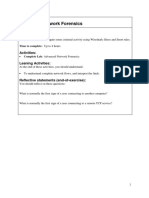0% found this document useful (0 votes)
36 views15 pagesAssignment
The document discusses analyzing network traffic from captured packets, including DNS, FTP, HTTP, and HTTPS traffic. It also covers analyzing attacks such as DDoS and brute force attacks. Various details are extracted from the traffic such as open ports, login credentials, transferred files, and IP addresses.
Uploaded by
nurbekbainazar5473Copyright
© © All Rights Reserved
We take content rights seriously. If you suspect this is your content, claim it here.
Available Formats
Download as PDF, TXT or read online on Scribd
0% found this document useful (0 votes)
36 views15 pagesAssignment
The document discusses analyzing network traffic from captured packets, including DNS, FTP, HTTP, and HTTPS traffic. It also covers analyzing attacks such as DDoS and brute force attacks. Various details are extracted from the traffic such as open ports, login credentials, transferred files, and IP addresses.
Uploaded by
nurbekbainazar5473Copyright
© © All Rights Reserved
We take content rights seriously. If you suspect this is your content, claim it here.
Available Formats
Download as PDF, TXT or read online on Scribd
/ 15
























































































